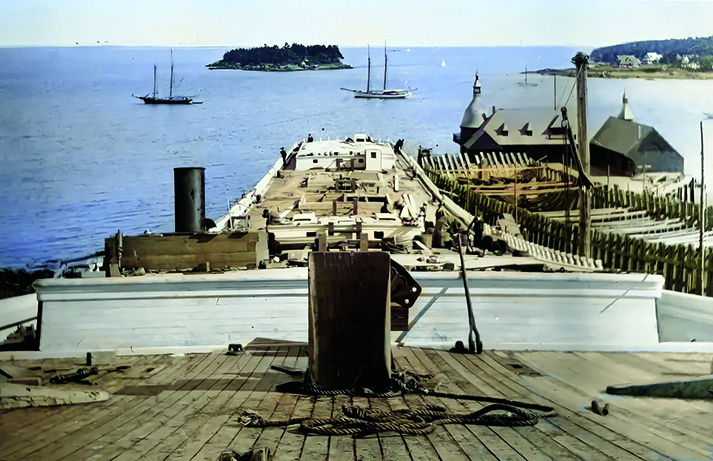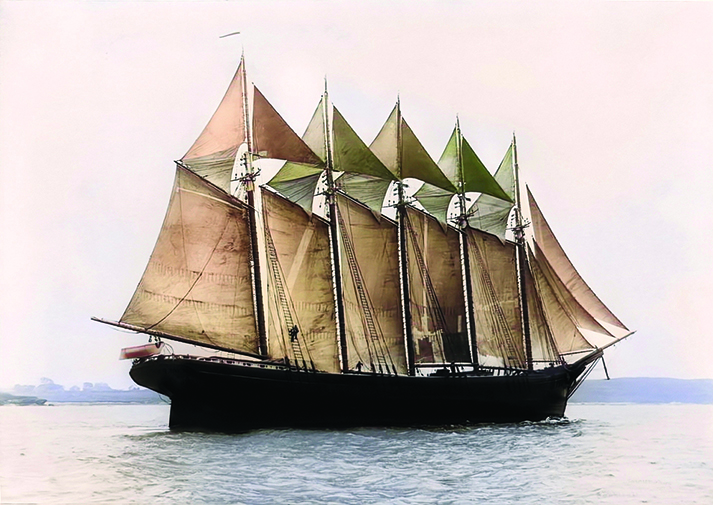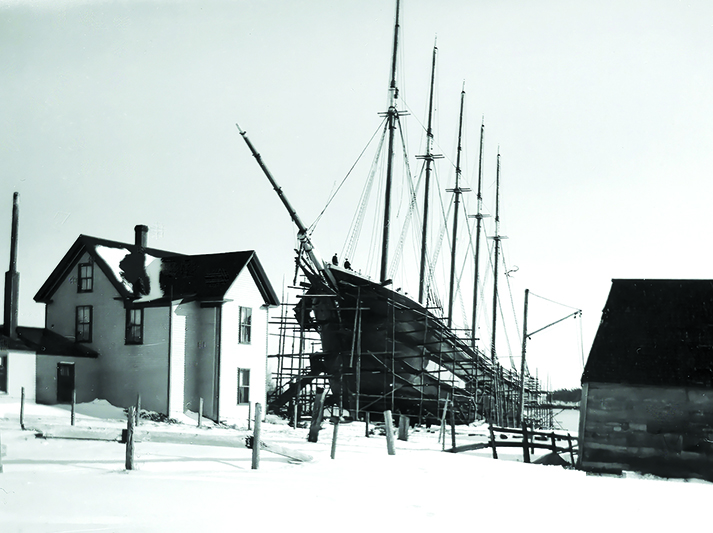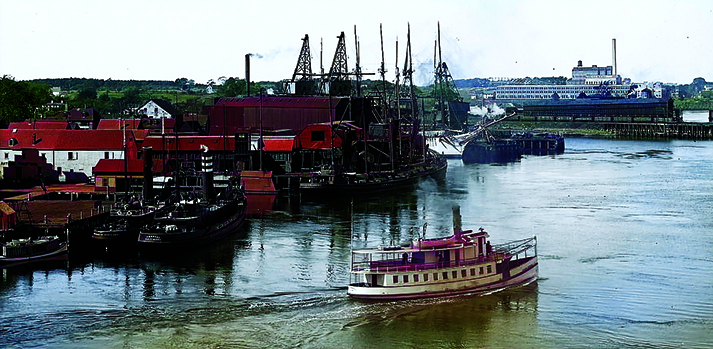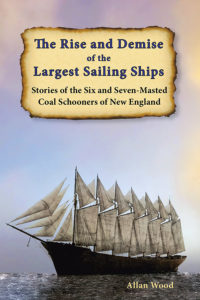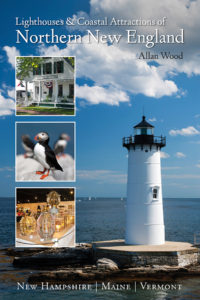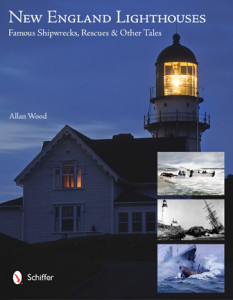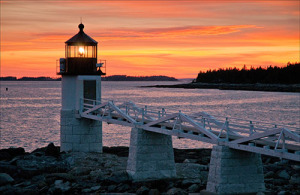Building The Largest Sailing Ships in New England: The Five and Six-Masted Coal Schooners
In the mid-1800s, America’s insatiable appetite for coal as the primary energy source and the need for timber and steel for construction for national expansion caused a desperate need to transport these resources in bulk along the East Coast. Many of these carriers were initially three-masted sailing schooners and square-rigged vessels. Some refer to this period as the “Golden Age of Sail” due to the popularity and efficiency of these sailing ships. Hundreds of shipyards had sprung up all over America’s coastline, with most along the rugged New England coast. Some coal-fired vessels, like steamships or steamers, were less reliant on the trade winds than their sailing counterparts. They were also dependable in delivering cargo on time. However, the early steamships did not have the range needed for extended voyages; they required more sailors to run the ship, and many could not carry as much cargo as larger sailing ships.
Early merchant or cargo ships used the square-rigged sail design, where wooden horizontal spars carried most of the primary sails perpendicular to the masts. They were slower than schooners and needed large crews of at least 30 men to climb up in the rigging to raise and lower the sails and maintain the ship. With their triangular and angular four-sided sails, schooners proved to be the favored design for hauling coal over the previous “square riggers.” These coal schooners, or colliers as they were called, were explicitly designed as bulk cargo ships to carry large quantities of coal in one trip. Their unique sail design gave these vessels unlimited range as they relied only on sail propulsion, although they depended on weather conditions. They were faster in deep open waters and were relatively inexpensive to operate, as they could be handled by smaller crews, saving ship owners money on hiring sailors.
With the increasing demand for coal and construction materials, and since delivering resources and supplies to distant points was expensive to charter, this provided healthy profits for the owners of these vessels. By the 1870s, most of the coal would be collected and shipped from ports in the Mid-Atlantic cities of Philadelphia and Baltimore and down the Chesapeake Bay to the Hampton Roads region near Newport, Virginia. Transporting more significant quantities of cargo over long distances encouraged shipbuilders to begin designing and building larger sailing ships. As a result, larger four-masted schooners were developed between the 1880s and the early years of the 20th century to carry large quantities of coal, steel, and timber along the Eastern Seaboard. Railroads and barges along rivers transported cargoes from these coastal ports to destinations inland.
With these ships’ increased length and tonnage, some architects investigated adopting a fifth mast to help manage the vessel’s many sails. The decision to use five masts would increase the number of sails while decreasing the size of the main sails to make them more manageable. Many shipbuilders believed that as the demand for coal would increase, so could the size of the ships built to carry it. The Governor Ames was the first wooden five-masted schooner built on the East Coast. It was named after Oliver Ames (former Governor of Massachusetts) and designed by Albert Winslow of Taunton, Massachusetts. The giant ship, built at the Leavitt-Storer Shipyard in Waldoboro, Maine, in 1888, was the world’s largest sailing cargo vessel at 265 feet long.
On her maiden voyage, the new largest ship had her front foremast snap in a strong gale storm, taking most of the other masts with it, rendering the vessel helpless in the seas. The anchor chain also broke, and the schooner ran aground, which became highly publicized as a failure. After costly revisions, she regained her reputation by sailing cargo from Baltimore to San Francisco, rounding Cape Horn at the tip of South America to reach the West Coast.
In 1893, America fell into a deep economic depression. For the next four years, the Governor Ames mainly hauled timber cargo along the West Coast as coal shipping was highly competitive between owners, and profits were minimal. The depression lasted about five years, as shipbuilding and other manufacturing industries remained idle, waiting for the economy to recover. The five-master would be sent to Australia with a load of lumber, then on to Hawaii, before returning for service on the West Coast. She later returned to the East Coast to deliver cargo to Liverpool, proving her efficiency.
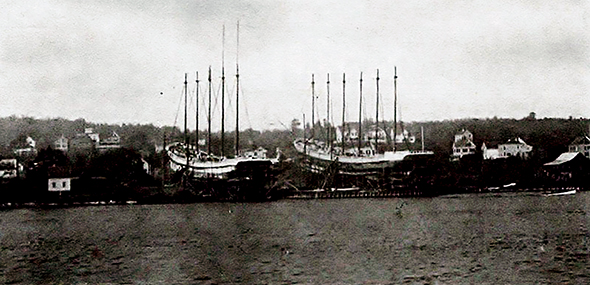
Percy and Small Shipyard in Bath, Maine, is building a five-masted and six-masted schooners.
Image Library of Congress
In 1894, the Percy & Small Shipyard started building wooden ships in Bath, Maine. After surviving the economic depression, it became the epicenter of wooden commercial shipbuilding on the northern East Coast. The shipyard specialized in building large wooden sailing schooners called “downeasters” to haul coal primarily from the Mid-Atlantic states through New England into Canada. Architect shipbuilder Nathaniel T. Palmer initially designed the four-masted schooner with its unique sails and deep wooden hull.
A decade later, with the economic depression over, America’s economy returned with a vengeance. The need for coal, lumber, and steel for construction prompted builders to continue designing larger ships. Palmer launched the second five-masted ship from the East Coast at the Percy & Small Shipyard in Maine in early December 1898. It was aptly named the Nathaniel T. Palmer, in legacy to himself, at 295 feet long over her deck, also justifying the need for a fifth mast. It was the largest ship in the world, but it would be the last ship he would build as he mishandled his finances and sold his management interests to the J. S. Winslow & Company. He had previously built five other four-masted schooners that were very profitable. His effective designs became a template for future vessels and helped pave the way for adopting wooden four and five-masted schooners for the coal and building trades.
The Cowley family established the Coastwise Transportation Company in Massachusetts and became principal investors who wanted to be involved in building great ships. Captain John G. Crowley, one of the brothers at sea since he was a boy, was the primary manager and investor. He contracted to build a giant wooden five-masted schooner, the John B. Prescott, at the Holly M. Bean Shipyard in Camden, Maine. He hoped it would be the first launched on the East Coast in a decade on January 13, 1899, but found himself beaten by the Nathaniel T. Palmer, launched five weeks prior. However, his ship did earn the distinction of being the new largest five-masted wooden schooner constructed at the time at 318 feet over her deck. Over 10,000 people showed up for the launching on that cold January day. The great vessel was also sheathed in iron to protect it from the ice.
The early 1900s involved the construction of many five-masted schooners. These massive vessels, with deep wooden hulls, were designed to carry large quantities of coal, timber, and steel along the East Coast. They could take much more cargo in one trip than their smaller competitors. With some delays occurring during periods of high demand at some coal ports, these larger vessels could effectively acquire and deliver their cargo more promptly.
Four and five-masted schooners could carry 3,000 to 4,400 tons of cargo. However, with the new economy booming, the race was on among shipbuilders to effectively design larger six-masted schooners to transport even more coal and construction materials to increase profits, with capacities of delivering between 5,000-6,000 tons. The creation of these giants became a reality between 1900-1909. The first of these largest vessels was the George W. Wells, constructed in 1900 at the Holly M. Bean Shipyard in Camden, Maine, under the direction of Captain Crowley. He wanted the notoriety of being the first to launch a six-masted vessel. Being highly competitive, he had started working on plans immediately after launching the five-masted John B. Prescott.
The Holly. M. Bean Shipyard also became one of the premiere shipyards in Maine, named after its owner, who was an architect and master shipbuilder himself. John Wardwell assisted Bean as the designer for many ships built there. Although known primarily for making three and four-masted vessels, the shipyard would have the distinction of producing the largest five-masted schooner in 1899, the John B. Prescott and the first six-master ever built, the George W. Wells in 1900. Some years later, in 1917, the shipyard also built the largest four-masted schooner, the Charlotte A. Maxwell.
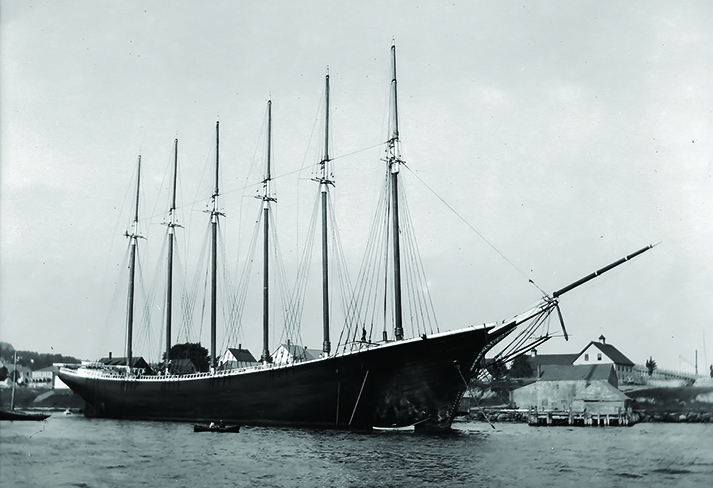
The first six-masted schooner, the George W. Wells in Camden Harbor in Maine (1900).
Image Camden Public Library.
Many of the wealthy flocked to Camden for its internationally known beauty. They helped to provide an infusion of money and resources to support the construction trades and local shipyards. Camden also had specialized industries in the region, like an anchor factory and an oakum factory used by local shipyards. Oakum is the substance used in the caulking process to fill areas between timbers in wooden vessels to make ships watertight.
From 1900 to 1909, Maine shipyards produced nine of the ten original six-masted giants that would be built, with seven at the Percy & Small Shipyard and two further up the Maine coast. In Quincy, Massachusetts, the Fore River Ship & Engine Company built one of steel named the William L. Douglas. All these giant ships were longer than a football or soccer field. Only one seven-masted coal schooner, made of steel, the Thomas W. Lawson, was also built at the Massachusetts shipyard. The Coastwise Transportation Company helped finance both vessels. A few years later, they invested in another six-masted schooner of the original ten, the Mertie B. Crowley, at the Cobb, Butler, & Co. Shipyard in Rockland, Maine.
The original shipyard in Quincy, Massachusetts, was started by Alexander Graham Bell’s famous assistant (inventor of the telephone), Thomas A. Watson, in 1886. The Fore River Engine Company initially specialized in building quality engines in Braintree, Massachusetts. Watson and business partner Frank O. Wellington designed and built their first steel ship, the Barnacle, and made a nice profit. Realizing the venture’s profitability, they entered the steel-hull shipbuilding business. A few years later, with business booming, they moved downriver to Quincy, Massachusetts, and became The Fore River Ship & Engine Company. It developed into one of the world’s greatest shipbuilders of steel and iron and built steam engines for steamships and naval vessels.
These six-masted colliers included steam-powered “donkey” engines with a Hyde windlass machine that helped hoist and lower the sails and anchors and lift heavy equipment. Beforehand, many crew members would be designated to perform the tasks. With this early automation, these schooners could sail with their heavy cargo with relatively small crews on board, lowering the cost of daily operations.
By 1910, about 45 five-masted schooners, 10 six-masted schooners, and one record-breaking seven-masted schooner had been built chiefly in Maine, with some in Massachusetts. The J. S. Winslow & Company primarily owned most of those vessels that were constructed in Maine. Additional coal delivery ports, also used to deliver other types of cargo like timber and other construction materials, were built for the Boston and Maine Railroad coastal network in the Northeast. They were established near railroad systems to distribute freight to points west and as far north as Canada. These deep-water ports were developed in Salem in Massachusetts, Portsmouth in New Hampshire, and up into Searsport in mid-coast Maine, on northern Penobscot Bay. Mariners called them tidewater coal landings or tidewater terminals.
One other prominent financial investor in some of the six-masted schooners built in Maine was Edward J. Lawrence. He owned cotton and textile mills in Waterville, Maine, and depended on coal for his businesses. He had three six-masted ships built in his last name: two named after his daughters Addie and Alice, and the last one in his name, constructed in 1908.
After the turn of the century, these schooners were used in the coastal trade between Canada and the United States, eventually sailing to other countries to deliver and acquire cargo from the West Indies, South America, Europe, and West Africa. When the Great War began in 1914, those still in service were used for transporting munitions and supplies across the Atlantic. Skillful captains who ventured the dangerous journey to Europe and were able to avoid the German U-boats were paid handsomely for their efforts.
Books to Explore
The Rise and Demise of the Largest Sailing Ships: Stories of the Six and Seven-Masted Coal Schooners of New England. In the early 1900s, New England shipbuilders constructed the world’s largest sailing ships amid social and political reforms. These giants were the ten original six-masted coal schooners and one colossal seven-masted vessel, built to carry massive quantities of coal and building supplies and measured longer than a football field! This book, balanced with plenty of color and vintage images, showcases the historical accounts that followed these mighty ships.
The information mentioned above is a component of the first chapter of this book, which provides a backdrop of the era of these massive ships, involving specific challenges in the industry, social changes, reforms, and the evolution of rescue services at this time. The rest of the chapters provide stories of each of the eleven ships.
Available in paperback, hardcover, and as an eBook for all devices.

Book – Lighthouses and Coastal Attractions in Southern New England: Connecticut, Rhode Island, Massachusetts
My 300-page book, Lighthouses and Coastal Attractions of Southern New England: Connecticut, Rhode Island, and Massachusetts, provides memorable human interest stories from each of the 92 lighthouses. You can explore plenty of indoor and outdoor coastal attractions, including whale-watching excursions, lighthouse tours, parks, museums, and even lighthouses where you can stay overnight. You’ll also find plenty of stories of hauntings around lighthouses.
My 300-page book, Lighthouses and Coastal Attractions of Northern New England: New Hampshire, Maine, and Vermont, provides special human interest stories from each of the 76 lighthouses, along with plenty of indoor and outdoor coastal attractions you can explore and tours. Attractions and tours include whale watching, windjammer sailing tours, lighthouse tours, unique parks, museums, and lighthouses where you can stay overnight. There are also stories of haunted lighthouses in these regions.
There are over 50 stories in my book New England Lighthouses: Famous Shipwrecks, Rescues & Other Tales. This image-rich book also contains vintage images provided by the Coast Guard and various organizations and paintings by six famous artists of the Coast Guard.
You’ll find this book and the lighthouse tourism books from the publisher Schiffer Books or in many fine bookstores like Barnes and Noble.
Copyright © Allan Wood Photography; do not reproduce without permission. All rights reserved.
Join, Learn, and Support The American Lighthouse Foundation
